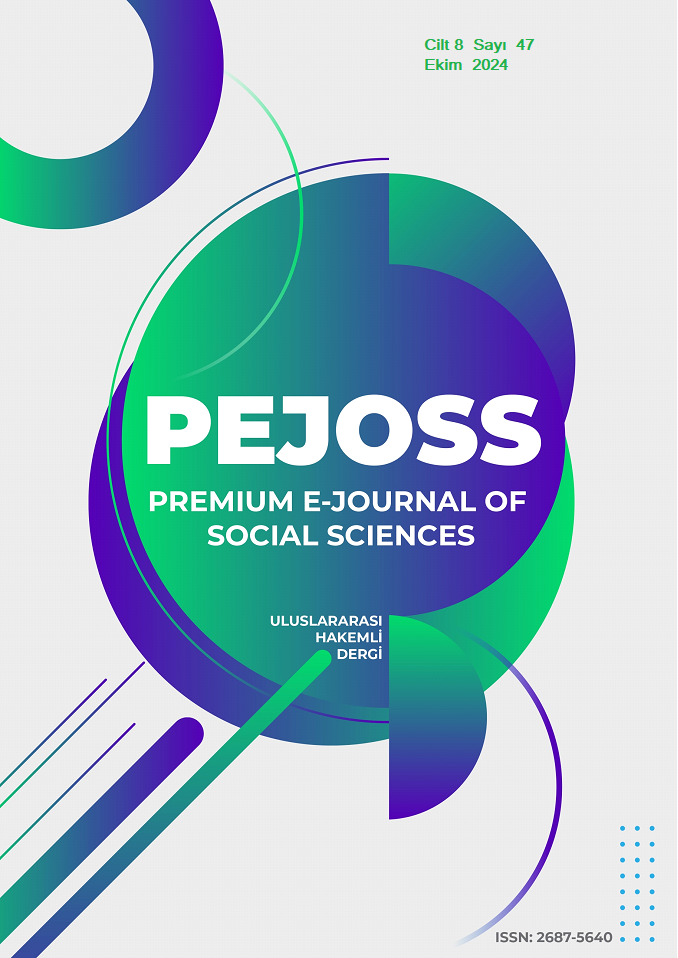Antik Yunan Ses Sistemine Bir Bakış
DOI:
https://doi.org/10.5281/zenodo.14020753Anahtar Kelimeler:
Antik Yunan Müziği, Antik Yunan Ses SistemiÖzet
Antik Yunan medeniyeti, müziği yalnızca estetik bir ifade biçimi olarak değil, aynı zamanda matematiksel, felsefi ve kozmolojik bir disiplin olarak ele almıştır. Müzik, Antik Yunan düşünce dünyasında hem bireysel ruhun eğitimi hem de toplumsal düzenin korunması açısından önemli bir yere sahiptir. Bu dönemde müziğe olan ilgi, sadece sanatsal bir uğraş olmaktan öteye geçmiş ve müziğin ahlak, matematik ve evrenle olan ilişkisi derinlemesine incelenmiştir. Özellikle Pisagor, Aristoksenos ve Platon gibi düşünürler, müziğin ahenk, matematiksel oranlar ve etik düzen ile bağlarını kurarak, müziği entelektüel bir disiplinin parçası haline getirmişlerdir.
Antik Yunan müziği, temelde tetrakordlar, harmonyalar ve tonoi gibi melodik ve yapısal unsurlara dayanır. Tetrakordlar, dört notadan oluşan sistemli diziler olup, müzikal yapının temelini oluşturur. Bu yapılar, birbirleriyle birleşerek harmonyaları ve harmonyalar bir araya gelerek daha karmaşık müzikal düzenlemeler olan tonoi sistemlerini meydana getirir. Harmonya kavramı, sadece müzikal bir uyumu ifade etmekle kalmaz, aynı zamanda kozmik düzenin bir yansıması olarak kabul edilir. Tonoi ise birden fazla harmonyanın birleşimiyle oluşan, müzikal modülasyonları ve farklı melodik dizilerin transpozisyonlarını mümkün kılan yapılar olarak öne çıkar.
Bu çalışmada, Antik Yunan müzik teorisinin temel unsurları olan tetrakordlar, harmonyalar ve tonoi incelenmekte ve bu yapıların Antik Yunan’ın düşünsel ve kültürel yapısındaki rolü ele alınmaktadır. Ayrıca, dönemin müzikal kuramları, çalgı sistemleri ve bu kuramların sonraki dönemlerde Batı müziği üzerindeki etkileri değerlendirilmektedir. Antik Yunan müziğinin matematiksel ve felsefi temelleri, müziğin evrenin ahenkli düzeni ile olan ilişkisinin bir göstergesi olarak bu çalışmanın ana odak noktalarından biridir.
İndirmeler
Referanslar
Anderson, D. W. (1994). Music and Musicians in Ancient Greece. Ithaca and London: Cornell Universty Press.
Apostolopoulos, T. (2021). The Musical System: Elaboration and development The Byzantine Period. Cenk Güray, Murat Salim Tokaç (Ed.) Anadolu ve Komşu Coğrafyalarda Makam Müziği Atlası Cilt.2, s.824-857. Ankara: Atatürk Kültür Merkezi Başkanlığı.
Apostolopoulos, T. & Skoulios M. (2021). Bı̇zans-Geç Bı̇zans Dönemı̇ne Aı̇t Müzı̇k Teorı̇sı̇ Kaynakları ve Bu Kaynakların Osmanlı Dönemı̇ Müzı̇k Kültürü ile Etkı̇leşı̇mı̇ne Daı̇r Dört Makale. Cenk Güray, Murat Salim Tokaç (Ed.) Anadolu ve Komşu Coğrafyalarda Makam Müziği Atlası Cilt.2, s.807-822. Ankara: Atatürk Kültür Merkezi Başkanlığı.
Ayata, E. (2020). Tarihten Günümüze Müzik ve Matematik İlişkisi. Pearson Journal Of Social Sciences & Humanities, 5/9, s.62.73.
Barker, A. 1989. Greek Musical Writings, 2: Harmonics and Acoustics. Cambridge: CUP.
Barker, A. 2007. The Science of Harmonics in Classical Greece. Cambridge: CUP. Baysal, Ozan (2014). Aristoksenus’un Müzik Bilim Anlayışı. Akademik Barış Dergisi, 46, s.62-83.
Baysal, O. (2014). Erken Dönem Pisagorcularda Harmonia Düşüncesi ve Müzik Kuramı. İTÜ TMDK Porte Akademik Müzik ve Dans Araştırmaları Dergisi, 10.
Bora, Uzay. (2020). Bı̇lı̇m ve Sanatın Kesı̇ştı̇ğı̇ Temel Bı̇r Nokta: Matematı̇k ve Müzı̇k İlı̇şkı̇sı̇. Uludağ Üniversitesi Eğitim Fakültesi Dergisi, 14/1, s.53-68.
Can, C. M. (2001). XV. Yüzyıl Türk Musikisi Nazariyatı (Ses Sistemi). (Doktora Tezi) Marmara Üniversitesi, Sosyal Bilim Enstitüsü. İslam Tarihi ve Sanatları Anabilim Dalı, İstanbul.
Güngör Sarıkaya, M. E. (2022). Antik Yunan Modları ile Makamların Karşılaştırılmalı İncelenmesi ve Arp İcrası ile Örneklenmesi. (Yayımlanmamış Yüksek Lisans Tezi), Hacettepe Üniversitesi, Ankara.
Güray, C. (2017). Bı̇n Yılın Mı̇rası Makamı Var Eden Döngü: Edvar Geleneği. İstanbul: Pan Yayıncılık.
Külcü R. (2018). Hermeneutik Okumalar I: Empedokles’de Sevgi ve Nefret Kavramlarının Entropi Ekseninde Okunması, Akademia Sosyal Bilimler Dergisi, 4/1, s.53- 61.
Levin, R, F. (2009). Greek Reflections On The Nature Of Music. New York: Cambridge Universty Press.
Monro, D, M. (1894). The Modes of Ancient Greek Music. Oxford: Clarendon Press.
Nowacki, E. (2020). The Ancient Harmoniai. In Greek and Latin Music Theory: Principles and Challenges (pp. 11-23). Boydell & Brewer. Doi:10.1017/9781787449169.003
Nowacki, E. (2020). The Tonoi. In Greek and Latin Music Theory: Principles and Challenges (pp. 24-41). Boydell & Brewer. Doi:10.1017/9781787449169.004
Öztürk, O. M. (2021). Makam Nazariyat Tarihinde Başlıca Gelenek ve Modeller. Cenk Güray, Murat Salim Tokaç (Ed.) Anadolu ve Komşu Coğrafyalarda Makam Müziği Atlası Cilt.1, s. 3-71. Ankara: Atatürk Kültür Merkezi Başkanlığı.
Solomon, J. (1984). Towards a History of Tonoi. The Journal of Musicology, 3/ 3, s. 242-251.
Strunk, O. (1950). Source Readings in Music History from Classical Antiquity through the Romantic Era. New York: W.W. Norton & Company.
Tura, Y. (2018). “Eskı̇ Yunan, Bı̇zans ve Türk Müzik Kuramları Arasındakı̇ İlı̇şkı̇ler.” Ç. Adar (Ed.). IX. Uluslararası Hisarlı Ahmet Sempozyumu: 10-12 Mayıs 2018 – Kütahya: Müzik Teorileri (s.404-422). Afyonkarahisar: Matbaa-i Beka.
West, M., L. (1992). Ancient Greek Music. Oxford: Clarendon Press.
İndir
Yayınlanmış
Nasıl Atıf Yapılır
Sayı
Bölüm
Lisans
Telif Hakkı (c) 2024 Premium e-Journal of Social Sciences (PEJOSS)

Bu çalışma Creative Commons Attribution 4.0 International License ile lisanslanmıştır.


